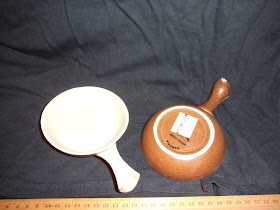Most of these clones will tell you that the pottery was begun by Arthur Rowden Toplis in the 1930s. Arthur is described as the third manager of New Zealand Insulators, the parent company of Temuka. It goes back well before then and well after.
Temuka is a small town located on the Canterbury Plains of the central south island of New Zealand 15km north of Timaru. The North Otago museum at Oamaru has a collection of Temuka pottery but it seems they want to divest.
Way back in 1868, Joseph Whitehead began brickworks in Temuka. William Hoare and his partner Page began a brickworksnear Whitehead in 1894 in Temuka. The Temuka Pipe Company took over the works in 1909. In 1916, was bought by John Redpath. He owned a small insulator company and asked Peter Mc Skimming to join him. (I included this bit because Mc Skimming are still a well-known NZ company.) Dominion Porcelain and Tile took over in 1922.
New Zealand Insulators took over in 1924. This is just a potted early history. There is a lot more but you can chase that up yourself.
Arthur died at Temuka on the 9th of June 1938 at the age of 53. He was buried at the Temuka Cemetery on the 11th of Hune 1938. He was survived by his wife Mabel. The managers before Arthur were RH Taylor (a former owner), and JG (Jock) Ritchie. Arthur is describes as a skilled craftsman and an experienced potter. Arthur has learned his craft in England, (many Toplis’s are from Derbyshire, in the centre of English potteries.) and later Portugal.
Later, Thomas Pickering took over as manager in 1941. He had run his own potteryuntil 1938when increasing competition forced it to close.
It was said during the Cold War, (remember that one, boomers?) only three things would survive a nuclear holocaust; ants, cockroaches and New Zealand Railways cups. And the first two would make it only if they were hiding under the cups.
Together with George Pickering, they began making items as Christmas presents for customers of their parent company National Electric and Engineering Company (NEECO). Things such as vases, teapots and mixing bowls.
We can jump forward to the 1970s now, skipping over a fire in the 1950s that led to resumption of production of electric jug bodies. In 1966 NEECO was sold to Cable Price Downer Ltd. Thomas Lovatt was replaced as Manager and the production of domestic pottery declined. Thomas after his retirement from Temuka together with his sons in 1966 later began Te Rona pottery. Thomas died in 1966.
These ramekins are a product of the 1970s. Any colour as long as it is brown. Temuka produced a range of stoneware in lovely brown. Remember those sets of kitchen storage jars of varying sizes? Those lovely brown coffee sets? So popular, that a new pottery was built in 1977. Come on boomers, you must have the remnants of a brown stoneware dinner set hidden away at the back of a dusty kitchen cupboard?
Anyway, the company is still in business today. A lot of their early output is highly collectible, so if you see any, buy them.
